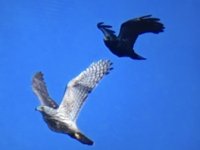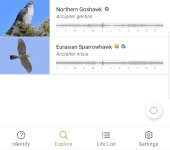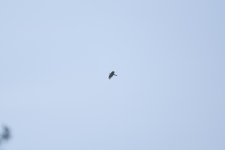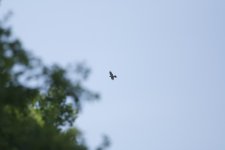-
Welcome to BirdForum, the internet's largest birding community with thousands of members from all over the world. The forums are dedicated to wild birds, birding, binoculars and equipment and all that goes with it.
Please register for an account to take part in the discussions in the forum, post your pictures in the gallery and more.
You are using an out of date browser. It may not display this or other websites correctly.
You should upgrade or use an alternative browser.
You should upgrade or use an alternative browser.
Charente- France, Sparrowhawk?, 02/06/2023 (1 Viewer)
- Thread starter Bewick
- Start date
More options
Who Replied?Bewick
Connoisseur of WTL

I’m going to still leave it inconclusive.# 19 is not the same bird as OP is Goshawk and this one is Sparrowhawk
You already said this - it's not helpful to repeat it - nor is it nice to tell the OP that effectively he is wasting his time by posting more photos. Nor is it good to assume that one set of photos of a bird not obviously moulting shows the same bird as one that obviously is moulting.the identification is undisputable
RafaelMatias
Unknown member

Indeed, this time a (moulting) female.# 19 is not the same bird as OP is Goshawk and this one is Sparrowhawk
lou salomon
the birdonist
this one is a different bird, a sparrowhawk (note barred secondaries). And yes, I'm certain about the first being a Goshawk, adult male.Sadly it was too far again, but this was taken in the same area today... I will be going back to get better photos.
Bewick
Connoisseur of WTL

May I ask what is best to look out for to make the separation of both birds when distant?this one is a different bird, a sparrowhawk (note barred secondaries). And yes, I'm certain about the first being a Goshawk, adult male.
lou salomon
the birdonist
it's a bit of experience you need to get the "feel" of Goshawk in distant birds - protruding head, bulging secondaries and - well - size, if you have a mobbing crow around: even a male Gos is slightly larger (wingspan) than a Carrion Crow or at least as large as the crow. Female Sparrowhawks already are dwarfed by crows.May I ask what is best to look out for to make the separation of both birds when distant?
Richard Dale
Well-known member
With any relatively scarce species, very often the key to their identification in the field is to become really, really familiar with the more common confusion species. Watch sparrowhawks whenever you encounter them. Really watch them. Especially females. Watch them for long periods, at long range, when soaring, gliding and flapping. If you're old school, like me, you might even take notes(!). Build up your familiarity such that you recognise their quirks of structure and methods of flight, even in brief or distant views. There are lots of subtle cues of structure - the shape of the wings from different angles and at different points of the flight 'envelope' and flight action - the speed and depth of wingbeats, the length of glides, etc. that build up a picture of a bird in you mental database. Then, when you do encounter a goshawk, it should immediately stand out as different.May I ask what is best to look out for to make the separation of both birds when distant?
The most obvious feature to me is the different wing structure - fuller, more bulging secondaries and a longer, slightly narrower hand than a sparrowhawk, which is particularly noticeable at certain angles as a bird circles, but in addition to this, there are various features already mentioned, such as a more protruding head (often set off by a very deep, powerful chest), which can combine with the longer wings to give a cross like silhouette at very long range, not seen with the sparrowhawk's subtly more compact structure.
Of course, any raptor in flight goes through endless changes in posture, and a single photograph can often be misleading - wings flexed a little more than usual, head pulled in slightly - whereas these things even out over a more prolonged period of observation. However, going back to the original photos, there is everything needed there to be 100% confident in the identification - the second image in particular illustrates a typical goshawk flight posture, accentuating that secondary bulge and contrasting it with the hand, as well as showing the head protruding well forward of the wings.
Rotherbirder
Well-known member

Sound advice; even then, on some views you will undoubtedly need to leave some individuals unidentified.With any relatively scarce species, very often the key to their identification in the field is to become really, really familiar with the more common confusion species. Watch sparrowhawks whenever you encounter them. Really watch them. Especially females. Watch them for long periods, at long range, when soaring, gliding and flapping. If you're old school, like me, you might even take notes(!). Build up your familiarity such that you recognise their quirks of structure and methods of flight, even in brief or distant views. There are lots of subtle cues of structure - the shape of the wings from different angles and at different points of the flight 'envelope' and flight action - the speed and depth of wingbeats, the length of glides, etc. that build up a picture of a bird in you mental database. Then, when you do encounter a goshawk, it should immediately stand out as different.
The most obvious feature to me is the different wing structure - fuller, more bulging secondaries and a longer, slightly narrower hand than a sparrowhawk, which is particularly noticeable at certain angles as a bird circles, but in addition to this, there are various features already mentioned, such as a more protruding head (often set off by a very deep, powerful chest), which can combine with the longer wings to give a cross like silhouette at very long range, not seen with the sparrowhawk's subtly more compact structure.
Of course, any raptor in flight goes through endless changes in posture, and a single photograph can often be misleading - wings flexed a little more than usual, head pulled in slightly - whereas these things even out over a more prolonged period of observation. However, going back to the original photos, there is everything needed there to be 100% confident in the identification - the second image in particular illustrates a typical goshawk flight posture, accentuating that secondary bulge and contrasting it with the hand, as well as showing the head protruding well forward of the wings.
RB
Valéry Schollaert
Respect animals, don't eat or wear their body or s
It seems the OP commented that he needed better pics, apparently ignoring my comment that it was not need. I guessed he didn't read me so I reapted.You already said this - it's not helpful to repeat it - nor is it nice to tell the OP that effectively he is wasting his time by posting more photos. Nor is it good to assume that one set of photos of a bird not obviously moulting shows the same bird as one that obviously is moulting.
I didn't watch any photo of the second set, to do what ? Identification was already 100% certain. I will not waste time to watch more photos. I'm in a remote place in central America, internet is limited and I won't open a photo I don't need to see.
I think I was nice to help to identify the bird. Your comment, in opposite, is not nice. Worse, it is totally useless. Unless your passion in life is to make others waste their time, I suggest that next time you refrain to write this kind of comment. On Facebook or Twitter, I would block you immediately for this type of bad behaviour.

Just because Goshawks are rare in the UK doesn't mean they are so rare on the Continent. If you were a French birder, you'd probably tick it, but in Britain people are more scared of counting it because reasons (no offence). If it's a Goshawk here, it's a Goshawk there (unless there's yet another Accipiter closely resembling it in range). Have a look at Merlin's results for close to where I live today (attached below).
All I've learnt about identifying the pair was in here, but--for me--the most useful feature is the head: stout and relatively big (= Sparrowhawk) versus with a visible neck and relatively smaller (= Goshawk). In comparison, Goshawk is noticeably bigger overall (wingspan, etc.), but it has a head of similar size to Sparrowhawk, so the proportions are different in the end. Your photos are pretty good and show this feature convincingly; you haven't seen really bad photos. Here's a very informative thread: Bird of Prey ID. West Midlands, UK. from Index for ID Q&A. The pictures in #16 leave something to be desired (I guess they were taken many years ago with different equipment than nowadays), and yet they're still all identifiable as Goshawks.
All I've learnt about identifying the pair was in here, but--for me--the most useful feature is the head: stout and relatively big (= Sparrowhawk) versus with a visible neck and relatively smaller (= Goshawk). In comparison, Goshawk is noticeably bigger overall (wingspan, etc.), but it has a head of similar size to Sparrowhawk, so the proportions are different in the end. Your photos are pretty good and show this feature convincingly; you haven't seen really bad photos. Here's a very informative thread: Bird of Prey ID. West Midlands, UK. from Index for ID Q&A. The pictures in #16 leave something to be desired (I guess they were taken many years ago with different equipment than nowadays), and yet they're still all identifiable as Goshawks.
Attachments
Last edited:
Bewick
Connoisseur of WTL

Interesting, though I do not like the idea that their is any doubt. That’s why I sometimes put in birds that I’m already pretty certain of as it’s better to get a second, third etc opinion.
I will be going back in a few weeks, for a longer period of time. If they are in the area I’ll hopefully be able to find another one and take better photographs. I’m unsure how common they are in my area as it’s a pretty unreported place.
Thanks for the information.
I will be going back in a few weeks, for a longer period of time. If they are in the area I’ll hopefully be able to find another one and take better photographs. I’m unsure how common they are in my area as it’s a pretty unreported place.
Thanks for the information.
Bewick
Connoisseur of WTL

Just wanted to revisit this thread with the full sized images this time. First two slightly cropped second 2 are the originals.
Attachments

Also, maybe, try Merlin's Photo ID. I'm not saying it works well, but--from what I understand--it should be better at judging jizz and proportions than fine plumage features, and here you need the former. It should also have more photos of Sparrowhawks than Goshawks overall, so--if anything--it should be more biased towards considering Sparrowhawk rather than Goshawk.
Bewick
Connoisseur of WTL

Just did… still suggested goshawk as the most likely option… lmaoAlso, maybe, try Merlin's Photo ID. I'm not saying it works well, but--from what I understand--it should be better at judging jizz and proportions than fine plumage features, and here you need the former. It should also have more photos of Sparrowhawks than Goshawks overall, so--if anything--it should be more biased towards considering Sparrowhawk rather than Goshawk.
Bewick
Connoisseur of WTL

I’ll be going back in about two weeks- two weeks in Charente and one week in the Pyrenees so I’ll have plenty of time to try and get a goshawk.The extensive 'bandit mask' could be a feature as well???
Richard Dale
Well-known member
It's still a clear goshawk. All the diagnostic features present on the previous iterations of the photos are still present on these versions. If you're not happy with it, then put it down as an unknown, but you have been told what it is, and more importantly why it is what it is, by a number of very experienced and knowledgeable observers, including some with particular expertise with raptors. If you do not want to take the advice of such observers, by all means leave the bird unidentified in your records, but then why ask for such advice in the first place? If you require further help coming to your own conclusion, try here:
Northern Goshawk flight identification and ageing in the UK - Revised and updated
Northern Goshawk flight identification and ageing in the UK - Revised and updated
Users who are viewing this thread
Total: 2 (members: 0, guests: 2)








